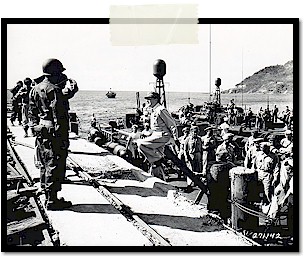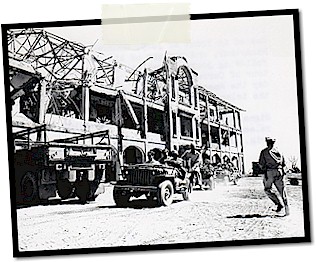|
The 503rd Parachute Infantry Regiment left the United States on 20
October 1942 on the old Dutch Motor, the Poelau Laut, which had just been
converted from a cargo ship to a troop transport.
The
ship was built in 1929 in Amsterdam, Netherlands and had served, in the interim,
to handle cargo between Europe and the Dutch East Indies.
For the time she was built her speed of 15 knots must have been very
satisfactory for that trade. The
ship had five cargo holds and gear for handling miscellaneous cargo utilizing a
lot of longshoremen.
The Poelau Laut had been designed to handle about thirty passengers on its
voyages to the Dutch East Indies. The
passengers, who must have lived a unhurried
life of leisure, occupying small but comfortable staterooms.
They had a spacious lounge where they could read, smoke and play cards.
The dining room, as well, was spacious for the number of people on the
passenger list.
When the United States entered World War II the country had only a few ships
designed to haul troops. Those,
which existed, were far from adequate to move the huge numbers of troops having
to be moved to the far reaches of the world.
Consequently ships like the Poelau Laut were taken over by the United
States and converted into vessels capable of moving large numbers of troops.
In the case of Poelau Laut all five cargo holds were fitted with a tiers of
canvas bunks, piled one on top of the other. Frequently, where there was (almost) adequate room, six tiers
of these bunks would be installed. The
top man had a long climb and woe to the man who would fall out of his bunk--it
was a long way to the deck. The
bunks were so close together it took a cooperative effort of the whole stack of
men for any one man to turn over. This
was a bit difficult to coordinate in the middle of the night.
Every Enlisted man was assigned to one of these dismal abodes.
Part of the deck in one hold was converted into mess facilities for the troops.
Since, in theory, the men had no heavy work to perform they would not get
hungry and need to have three meals a day, the whole shipload of men were fed
only twice a day. With the ship
almost at capacity and only two mess lines to handle the feeding of the troops,
the men spent many hours in line waiting for their food.
The officers had things a bit more luxurious.
The dining room which had served the 30 passengers was used to feed the,
roughly, two hundred officers of all ranks.
Individual tables, seating four, had been replaced by two long tables
serving about 20 officers at a time. A
wait was required for these tables but nothing to approach the Enlisted "chow
line".
 Beginning with the Lieutenant Colonels, of which there were a handful, and
reaching down into the high seniority Captains some officers were given state
rooms. Where there had been two
civilian passengers now there were six officers. This left the
low ranking Captains and the First and Second Lieutenants.
There were, probably, about 150 of these.
Four plywood boxes were built, two on each side of the ship, to house
these Officers. About 40 Officers
were crammed into each of these "cabins".
The bunks here were stacked three high, in most places, which, while not
well-appointed, can be endured. Each
of these "cabins" had a head, wash stands and showers served with fresh salt
water. Once in a very long time the
showers were supplied with fresh water from the ships evaporators. The evaporators were barely adequate for the needs of the
ship machinery, so fresh water showers were a rarity.
Beginning with the Lieutenant Colonels, of which there were a handful, and
reaching down into the high seniority Captains some officers were given state
rooms. Where there had been two
civilian passengers now there were six officers. This left the
low ranking Captains and the First and Second Lieutenants.
There were, probably, about 150 of these.
Four plywood boxes were built, two on each side of the ship, to house
these Officers. About 40 Officers
were crammed into each of these "cabins".
The bunks here were stacked three high, in most places, which, while not
well-appointed, can be endured. Each
of these "cabins" had a head, wash stands and showers served with fresh salt
water. Once in a very long time the
showers were supplied with fresh water from the ships evaporators. The evaporators were barely adequate for the needs of the
ship machinery, so fresh water showers were a rarity.
|







